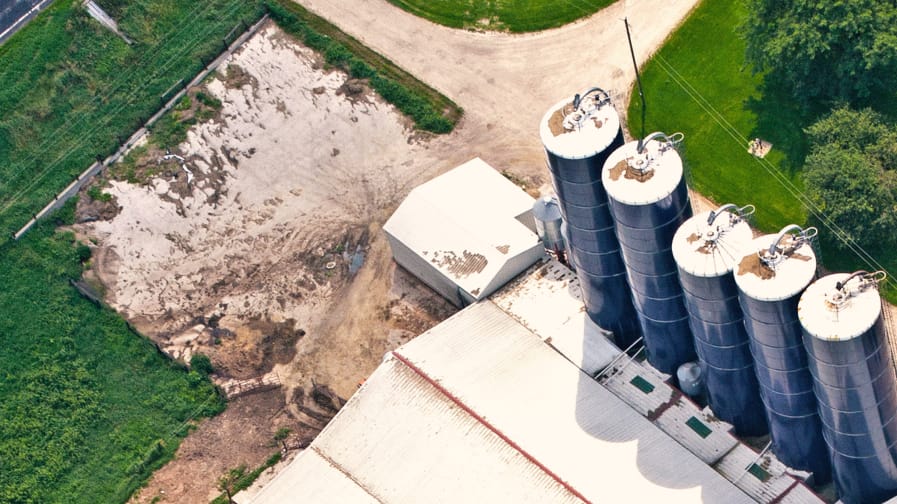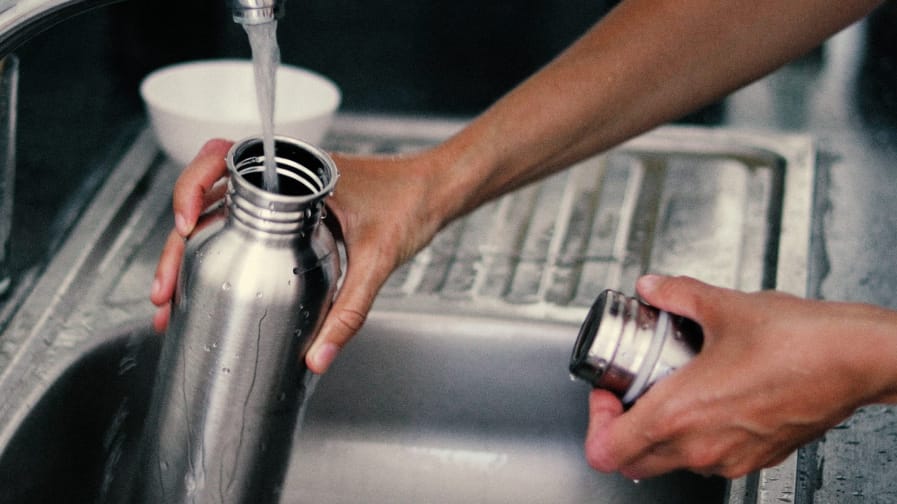What You’ll Learn From This Report
Key Findings and Recommendations
Climate change threatens New Mexico’s water security, and industrial agriculture is enabling this crisis by prioritizing profit over people. Wasteful mega-dairies, alfalfa, and pecans dominate across the state, draining residential wells and state aquifers dry. The state’s failure to collect adequate data inhibits future planning and fails to prepare for a changing future. A radical change in how New Mexico allocates and thinks about water is desperately needed, and Governor Lujan Grisham and the New Mexico Legislature must take immediate action to address the scale of this emergency.
Key Findings
- Drought, intensified by climate change, mismanagement of water resources, and corporate greed, is drying out New Mexico and putting millions of people at risk.
- Industrial-scale agriculture is the largest abuser of water, consuming more than 80 percent of the state’s freshwater and accounting for over 774 billion gallons yearly.
- Mega-dairies use an enormous amount of water, requiring 32 million gallons a day to maintain the dairy cows on New Mexico’s factory farms, or 11 billion gallons annually. Mega-dairies contaminate everything around them, with the government permitting them to generate 8.1 million gallons of waste every day and to contaminate groundwater.
- Two agricultural industries dominate water consumption. Alfalfa, the state’s dominant crop, guzzled 85 billion gallons of water in 2021, and pecan irrigation used another 93 billion gallons — sucking up 178 billion gallons between the two.
- New Mexico fails to adequately collect relevant data on aquifer water levels, groundwater status, well data, and water use by sector. These holes in water data make it impossible to properly plan for future and ongoing drought, leaving rural and low-income communities to fend for themselves.
- New Mexico’s water laws protect seniority and status quo management, allowing Big Ag to abuse its water rights at the expense of New Mexico’s people. State agencies do not consider climate change in assessment of water rights, and state drought plans are inadequate to protect future water security.

Key Recommendations
Governor Lujan Grisham must direct state agencies and task forces as follows:
New Mexico Drought Task Force
Update the New Mexico Drought Plan to include mandatory drought response actions specific to the threat that mega-dairies and other industrial agriculture, particularly alfalfa and pecan farms, pose to water supply and quality.
Office of the State Engineer
- Prioritize certain beneficial uses of water over others in times of shortage, putting residential and drinking water uses over industrial agricultural uses that deplete safe water supplies.
- Deny water permit applications for all new or expanding alfalfa, pecan, and mega-dairy operations as running counter to the public welfare and conservation of water.
New Mexico Environment Department
- Deny new groundwater discharge permits and permit renewals for mega-dairies discharging their polluted wastewater over sensitive aquifers that are already contaminated beyond state or federal safety standards.
- Issue stronger discharge permits that prevent mega-dairies from contaminating groundwater at the outset.
- Revoke permits when dairies repeatedly violate groundwater quality standards.
The New Mexico Legislature must appropriate sufficient funds to the Water Data Act and the key state agencies that administer it, to ensure access to a comprehensive database of water use and shortage information that can inform future water policy decisions and reforms.
Water and Drought in New Mexico
New Mexico faces severe impacts over the next few decades as climate change intensifies, worsening existing drought and historic aridity.1Frankson, Rebekah et al. Cooperative Institute for Satellite Earth System Studies. “New Mexico State Climate Summary 2022.” NOAA Technical Report NESDIS 150-NM. 2022; Dunbar, Neila W. et al. New Mexico Bureau of Geology and Mineral Resources. “Climate Change in New Mexico Over the Next 50 Years: Impacts on Water Resources.” March 2022 at vi. In 2022 alone, more than 90 percent of New Mexico was in severe drought, burdened by the largest wildfire in state history and some of the driest months on record.2Wallace, Tim and Nadja Popovich. “A ‘perfect recipe for extreme wildfire’: New Mexico’s record-breaking, early fire season.” June 1, 2022; Gewin, Virginia. “New Mexico farmers face a choice: Pray for rain or get paid not to plant.” Civil Eats. November 8, 2022. Droughts are projected to become more intense, with several studies predicting average temperature increases of up to 10 degrees Fahrenheit by 2100.3New Mexico Office of the State Engineer (OSE), Interstate Stream Commission (ISC). “New Mexico State Water Plan Part II: Technical Report.” December 6, 2018 at 16; Frankson et al. (2022).
New Mexico is not alone in this fight. Although punctuated by periodic wet years and heavy rain, the entire American West is consumed by a mega-drought, characterized as decades-long, intense periods of drought. Future conditions will be so much drier than the present that soil moisture levels that today would be considered indicative of a mega-drought are projected to become average by the end of the twenty-first century.4Dhanesha, Neel. “How are floods and droughts happening at the same time?” Vox. August 9, 2022; Williams, A. Park et al. “Rapid intensification of emerging southwestern North American mega-drought in 2020-2021.” Nature Climate Change. Vol. 12, No. 3. February 2022 at 1; Stevenson, Samantha et al. “Twenty-first century hydroclimate: A continually changing baseline, with more frequent extremes.” PNAS. Vol. 119, No. 12. January 2022 at 1; Sandronsky, Seth. “As California’s drought intensifies, the pain spreads.” Capital Weekly (CA). March 10, 2022. In New Mexico, water supplies will decrease as snowpacks thin and melt earlier, with runoff and recharge expected to decline by 3 to 5 percent per decade.5Dunbar et al. (2022) at vi to vii.
New Mexico depends on both surface and groundwater supplies, drawing from five major river basins and three smaller basins, as well as multiple groundwater basins.6NM OSE ISC. “Technical Report.” (2018) at 1 and 9. Water law is governed by prior appropriation and beneficial use, but water supplies are also tied up in eight separate interstate compacts, including the Colorado River Compact and two agreements with Mexico.7NM OSE ISC. “New Mexico State Water Plan Part III: Legal Landmarks.” December 6, 2018 at 1 and 5.
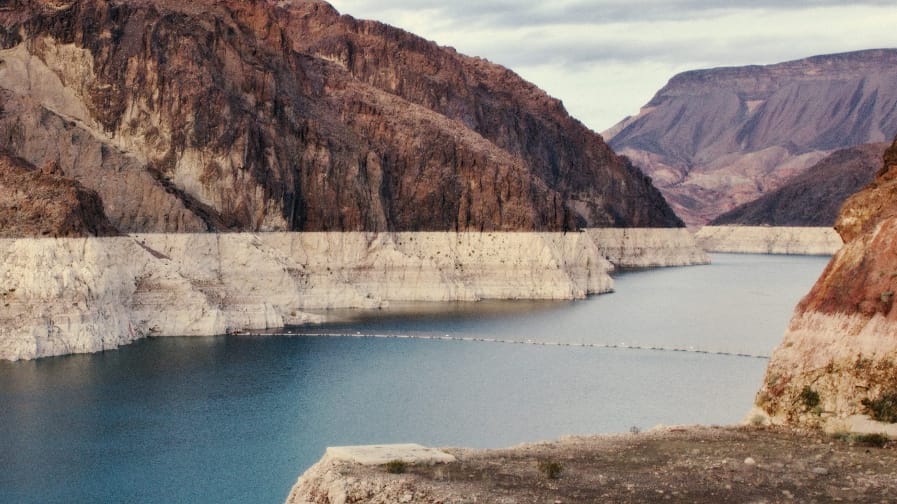
New Mexico is one of seven Western states governed by the Colorado River Compact, which allocates 16 million acre-feet of water annually.8Robison, Jason et al. “Challenge and response in the Colorado River Basin.” Water Policy. Vol. 16, Iss. S1. March 2014 at 16 to 17, 35. Established in 1922, the Compact distributes 7.5 million acre-feet to the Upper Basin, including New Mexico, and 7.5 million acre-feet to the Lower Basin.9Ibid. Indigenous tribes have historically been excluded from these discussions.10Sakas, Michael Elizabeth. “Historically excluded from Colorado River policy, tribes want a say in how the dwindling resource is used. Access to clean water is a start.” Colorado Public Radio. December 7, 2021. The Compact has reflected an overallocation since its founding, as only 12 to 13 million acre-feet flow through the river, and the situation was further exacerbated by a later treaty that guaranteed Mexico 1.5 million acre-feet.11Gardner, Jeff. “Deception and science in the Colorado River.” Desert Times. January 1, 2020; Fleck, John and Anne Castle. “Green light for adaptive policies on the Colorado River.” Water. Vol. 14, Iss. 2. 2022 at 2; Flavelle, Christopher. “As the Colorado River shrinks, Washington prepares to spread the pain.” New York Times. Updated January 31, 2023.
Because the Colorado River Compact relies on fixed numbers, there is no flexibility for declines in supplies. As water volumes continue to shrink, Upper Basin states will be unable to supply Lower Basin states with water unless drastic cuts are made.12Sakas, Michael Elizabeth. “If the Colorado River keeps drying up, a century-old agreement to share the water could be threatened. No one is sure what happens next.” Colorado Public Radio. November 19, 2021. New Mexico is entitled to 11.25 percent of the Upper Basin’s share at present.13Schatz, Justin. “New Mexico among states forced to reduce water usage from Colorado River.” Paper. December 15, 2021.
The nation’s two largest reservoirs, Lake Mead and Lake Powell, are supplied by the Colorado River and hold much of its water supplies.14Falconer, Rebecca. “Drought-hit Colorado River water supplies near ‘moment of reckoning.’” Axios. June 15, 2022; Bolinger, Becky. “Depleted by drought, Lakes Powell and Mead were doomed from the beginning.” Washington Post. September 10, 2021. Both have reached record lows, with the Bureau of Reclamation issuing its first-ever shortage declaration in 2022.15Bureau of Reclamation. U.S. Department of the Interior (DOI). Letter to Paul Davidson. Chief, Water Management Group Water and Power Division. “Operation Plan for Colorado River Reservoirs.” August 21, 2021 at 1 to 2. Temporarily, the federal government held water in Lake Powell to sustain its hydropower,16Fountain, Henry. “Colorado River reservoirs are so low, government will delay releases.” New York Times. May 3, 2022. but water levels may soon be too low to generate power or deliver water to the Lower Basin.17Partlow, Joshua. “Officials fear ‘complete doomsday scenario’ for drought-stricken Colorado River.” Washington Post. December 1, 2022.
New Mexico has been diverting water from the Colorado River based on historic flow assumptions, supplying drinking water to cities.18Perramond, Eric P. “Water rights, river compacts, and legal-policy stationarity in the American West.” Environmental Research Letters. Vol. 15. January 2020 at 5. Although the Colorado is drawing the most attention due to its wide-reaching impacts, New Mexico is also dependent on other drying waterways. Albuquerque and Santa Fe, for instance, are increasingly dependent on the Rio Grande, which in turn relies on unreliable supplies of imported water.19Ibid. at 6. A mixture of Rio Grande and Colorado river waters supply Albuquerque with 15 billion gallons annually.20Davis, Theresa. “Increasing pressure on Colorado River water in New Mexico.” Albuquerque Journal. September 14, 2022.
The Rio Grande ran dry for the first time in 40 years in 2022, exposing a jarring new reality for the state. Albuquerque will no longer be able to depend on getting half its water supply from the river.21Segarra, Curtis. “A dry river: Albuquerque’s ‘new hydrologic reality.’” KRQE. Updated August 11, 2022. Although the Rio Grande is accustomed to wet and dry cycles, it does not typically dry as far upstream as Albuquerque. Climate change and water mismanagement are causing drying events earlier and farther north.22Ibid.; Pratt, Sarah E. “Rio Grande runs dry, then wet.” NASA Earth Observatory. August 17, 2022. The state is also seeing historic lows at reservoirs across the river basin, inhibiting river recharge. New Mexico’s largest reservoir, Elephant Butte, reached one of its lowest levels in 50 years in 2022, reflecting a mere 4 percent capacity (see Fig. 1).23Pratt (2022); Water Desk, University of Colorado Boulder. “Data Viz: Elephant Butte Reservoir levels.” Updated September 21, 2022. Available at https://waterdesk.org/multimedia/data/data-viz-elephant-butte-reservoir-levels/; Texas Water Development Board. “Elephant Butte Lake.” Available at https://waterdatafortexas.org/reservoirs/individual/elephant-butte. Accessed April 2023.
The Colorado River’s supplemental supplies have helped the state temporarily reduce groundwater pumping, with the aim of recharging aquifer water tables. However, this only works if snowpacks and runoff are sufficient. In recent years, it has not been.24Davis (2022). Going forward, as climate change and drought intensify, these conditions will only worsen.25Ibid.; Segarra (2022); Pratt (2022).
Problem #1: Misallocation of Water for Corporations Over People
In New Mexico, over 80 percent of the state’s freshwater goes toward industrial agriculture, which accounts for more than 774 billion gallons yearly.26Burgess-Conforti, Jason R. U.S. DOI. Bureau of Land Management (BLM). “BLM Water Support Document for Oil and Gas Development in New Mexico.” BLM Water Support Document 2020. April 7, 2021 at 7; Food & Water Watch (FWW) analysis of Magnuson, Molly et al. “New Mexico Water Use by Categories 2015.” NM OSE. Technical Report 55. May 2019 at i. By comparison, public water supply and domestic wells account for 10 percent of water withdrawals (see Fig. 2).27Magnuson et al. (2019) at i. Agriculture is a $3 billion annual industry, representing only 3 percent of the state’s gross domestic product, making its water use extremely outsized.28Nelson, Cody. “New Mexico’s coming megadrought highlights farmers’ control of water.” NM Political Report. Merch 9, 2021.
New Mexico is naturally arid, receiving fewer than 15 inches of precipitation annually.29Frankson et al. (2022). This makes irrigation essential to growing crops on the 40 million acres of farmland across the state.30U.S. Department of Agriculture (USDA). National Agricultural Statistics Service (NASS). “2021 State Agricultural Overview: New Mexico.” www.nass.usda.gov/Quick_Stats/Ag_Overview/stateOverview.php?state=NEW percent20MEXICO. Water is sourced from surface water and groundwater, consuming more than 400 billion gallons and 360 billion gallons respectively.31FWW analysis of Magnuson et al. (2019) at i. This abuse of groundwater is especially concerning, with a New Mexico Bureau of Geology and Mineral Resources report describing the use of groundwater for irrigation as a “mining operation” that depletes aquifers without recharge.32Dunbar et al. (2022) at 85.
Three particularly egregious examples of water misuse are the water-thirsty dairy, alfalfa, and pecan industries. Each consumes far beyond its value, leaving drought and water shortages in its wake. New Mexico’s government must urgently re-evaluate its water priorities and rein in these industries before it is too late.
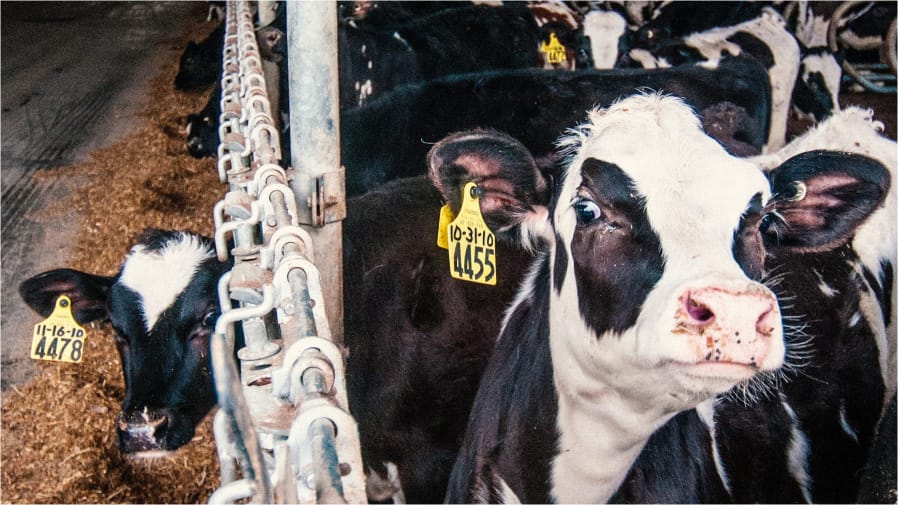
Mega-Dairies
Dairy is New Mexico’s largest agricultural sector.33Bustillos, Longino and Maria Bautista. USDA NASS New Mexico Field Office. “New Mexico Agricultural Statistics: 2018 Annual Bulletin.” November 2019 at 9 to 12. Food & Water Watch estimates that it takes 32 million gallons of water a day to maintain the dairy cows on New Mexico’s factory farms (those with 500 head or more), or 11.7 billion gallons annually. This is not the full lifecycle water footprint, since no information is available on the amount of livestock feed originating out of state.34USDA NASS. Quick Stats. quickstats.nass.usda.gov. Accessed August 2021; Mekonnen, Mesfin M. and Arjen Y. Hoekstra. University of Twente. “A global assessment of the water footprint of farm animals.” Ecosystems. Vol. 15. 2012 at 406 and 408. However, even this could supply 400,000 people with water for a year — 4.5 times the population of Santa Fe.35FWW analysis of USDA NASS. Quick Stats; Magnuson et al. (2019) at 8; U.S. Census Bureau. Santa Fe city, New Mexico. www.census.gov/quickfacts/fact/table/santafecitynewmexico/PST045221. Accessed February 2023.
The U.S. dairy industry has undergone changes in recent decades, as farms became fewer but larger, and cooperatives consolidated across larger regions. Most of the industry’s growth occurred in western states like New Mexico, where a favorable climate and affordable land allowed dairies to raise ever-increasing herds on factory farms.36Blayney, Don and Mary Anne Normile. USDA Economic Research Service (ERS). “Economic Effects of U.S. Dairy Policy and Alternative Approaches to Milk Pricing: Report to Congress.” Administration Publication No. 076. July 2004 at 3 to 5, 13, and 27 to 29; Hanawa Peterson, Hikaru. Kansas State University. “Geographic Changes in U.S. Dairy Production.” Presented at the Annual Meeting of the American Agricultural Economics Association. Long Beach, California. July 28-31, 2002 at 1 to 4; MacDonald, James M. et al. USDA ERS. “Consolidation in U.S. Dairy Farming.” ERR-274. July 2020 at 1, 5 to 7, and 18. Today, the state has about half as many small dairies (under 500 head) compared to 20 years ago. New Mexico also now touts some of the largest herd sizes in the country, with the average mega-dairy confining more than 3,000 cows.37FWW analysis of USDA NASS. Quick Stats. Accessed August 2019; Ogburn, Stephanie Paige. “A citizen activist forces New Mexico’s dairies to clean up their act.” High Country News. December 5, 2011.
This mammoth growth comes with serious waste consequences for New Mexico’s limited water supplies.
Together, the 336,000 cows living on New Mexico’s mega-dairies produce enough manure to overflow nine Olympic-sized swimming pools each day.
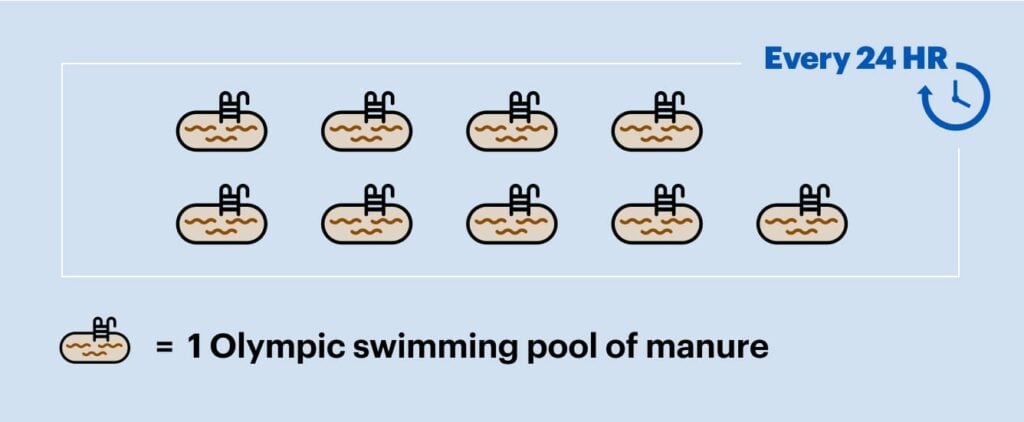
That is 11 times as much sewage as is produced by the Albuquerque metropolitan area.38FWW analysis of USDA NASS data; U.S. Census Bureau. Metropolitan statistical area population estimates. www.census.gov/data/datasets/time-series/demo/popest/2010s-totalmetro-and-micro-statistical-areas.html. Accessed December 2019.
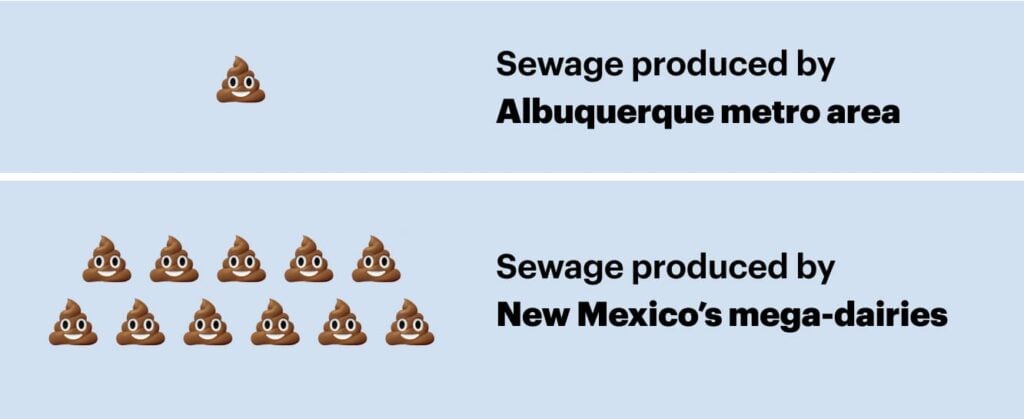
Yet 80 percent of New Mexico’s mega-dairies only have half the amount of land needed to absorb manure nutrients. Excess nutrients run off into surface water, creating a slew of problems including harmful algal blooms and fish kills.39Wang, Jingjing and Janak Raj Joshi. University of New Mexico. “Policy Alternatives for Controlling Nitrate Pollution From New Mexico’s Dairies.” New Mexico Water Resources Research Institute. Report No. 369. June 2015 at 3 to 4 and 45; Broud, Mike. Kansas State University. “Where do cows live? The strategy behind dairy barns.” Dairy Management, Inc. February 21, 2018; Sorrentino, Joseph. “Which milk: Practices on New Mexico’s conventional dairies are hard to swallow.” Santa Fe Reporter. December 16, 2014; New Mexico Environment Department (NMED). “Water resources & management.” Available at https://www.env.nm.gov/water. Accessed October 2020.
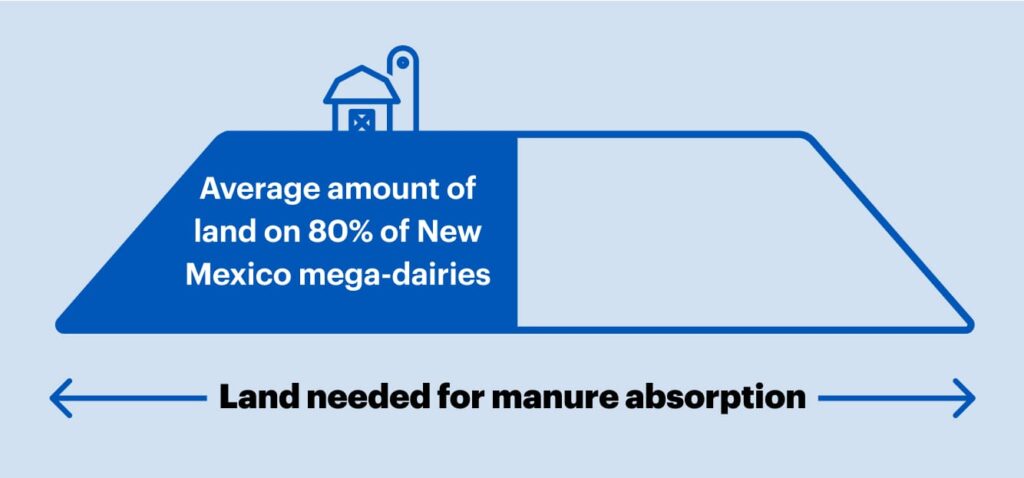
Meanwhile, dairies account for 20 percent of the state’s groundwater discharge permits.40Gleason, Megan. Source New Mexico. “State inspections lag for New Mexico’s primary drinking water source.” University of Colorado Boulder, Water Desk. August 24, 2022. Nearly all New Mexico dairies (179) either have or are seeking such permits. Collectively, these facilities are permitted to generate 8.1 million gallons of waste every day, or 2.9 billion gallons a year.41NMED. “Current List of Dairy Permits.” Available at https://www.env.nm.gov/gwqb/dairy. Accessed December 2022 and on file with FWW. Updated March 2021. The New Mexico Environment Department (NMED) recognizes that “this discharge or leachate may move directly or indirectly into groundwater of the State of New Mexico” via “potential sources of contamination,” including wastewater storage structures and land application fields.42Arroyo Dairy. Discharge Permit Renewal DP-764. March 5, 2019. Available at https://service.web.env.nm.gov/urls/WbjhQGZB. According to NMED’s interactive environment map, many, if not most, of these dairies are situated above aquifers marked as “high sensitivity.”43FWW analysis of NMED. OpenEnviroMap. Available at https://gis.web.env.nm.gov/oem/?map=swpa. Accessed January 2022.
In Doña Ana County in southern New Mexico, a stretch of 13 dairies has been monitored for groundwater contamination for years after complaints from nearby residents. Groundwater below the dairies was first found to contain high levels of nitrate, chloride, and total dissolved solids (TDS) in 2006, but this issue had still not been resolved in 2020. When tested in 2020, nitrate concentrations were higher than acceptable limits in 15 out of 25 wells sampled, while chloride and TDS concentrations exceeded standards in most wells. The highest level for chloride was over seven times the acceptable limit.44Muller, Gina and Jay Snyder. EA Engineering, Science, and Technology Inc. Prepared for Doña Ana Dairies. “Quarterly Groundwater Monitoring Report.” August 24, 2020 at 1 and 7.
This contamination poses grave dangers for nearby residents. The New Mexico Department of Health warns that nitrate contamination in groundwater may lead to nitrate poisoning, which interferes with the blood’s ability to carry oxygen from the lungs to the body.45New Mexico Department of Health (DoH). “Dairies and Human Health.” Available at https://www.nmhealth.org/publication/view/help/287. Accessed November 2022; NM DoH and NMED. “Nitrate in Drinking Water.” Available at https://www.nmhealth.org/publication/view/help/290. September 2003. Elevated levels in drinking water are linked to health problems, including cancer and blue-baby syndrome.46Swistock, Bryan. PennState Extension. “Nitrates in drinking water.” 2019 at 1. It is especially concerning for the 10 percent of New Mexicans who rely on smaller, unregulated household wells. Private wells are not subject to regular water quality testing requirements and may contain odorless or tasteless contaminants like nitrate.47NM DoH. “Water Quality.” Available at https://www.nmhealth.org/about/erd/eheb/wqp. Accessed August 2021; NM DoH and NMED (2003).
The Doña Ana study also found that the county’s water supplies were under serious threat. Groundwater levels decreased across the region, with numerous wells going dry since 2007.48Muller and Snyder (2020) at 10, 29 to 33, and 49. Other wells have dropped by over five feet, an unsustainable pace for those who live nearby.49Ibid. at 18 to 24. Since drinking water primarily comes from groundwater sources,50Burgess-Conforti (2021) at 8. the mega-dairies pose serious threats to nearby residents’ water access. Mega-dairies are exacerbating New Mexico’s water crisis, and it is past time to hold them accountable.
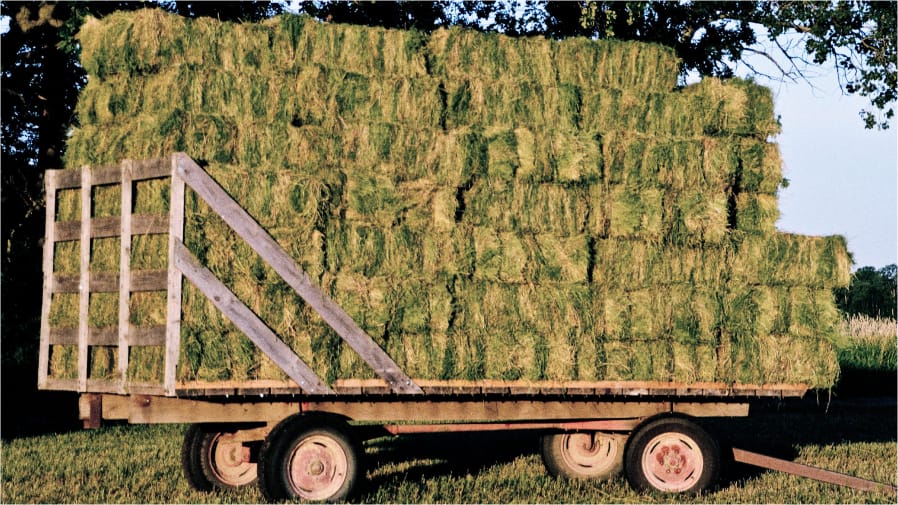
Alfalfa
Alfalfa is the dominant crop in New Mexico, harvested on 125,000 acres and valued at over $147 million annually.51USDA NASS. “2021 State Agricultural Overview.” It is a notoriously water-thirsty crop, used almost exclusively for livestock feed.52Magnuson et al. (2019) at 26; Wechsler, Seth J. and Daniel Milkove. USDA ERS. “Genetically modified alfalfa production in the United States.” Amber Waves. May 1, 2017. Food & Water Watch estimates that New Mexico’s alfalfa production required around 85 billion gallons of water in 2021. Using domestic water use estimates from the New Mexico Office of the State Engineer, this is enough to supply 2.9 million people in New Mexico for a year — 800,000 more than live in the state.53FWW analysis of USDA NASS. “2021 State Agricultural Overview”; Sloan, Jim. “How much water does alfalfa need?” University of Nevada, Reno. College of Agriculture, Biotechnology, & Natural Resources. 2009; Hanson, Blaine et al. University of California. “Chapter Seven: Irrigating Alfalfa in Arid Regions.” University of California Agriculture and Natural Resources. Publication 8293. April 2008; Magnuson et al. (2019); U.S. Census Bureau. “Quick Facts — New Mexico.” Available at https://www.census.gov/quickfacts/NM. Accessed December 2022.
Water is the largest factor in alfalfa production,54Lauriault, Leonard et al. New Mexico State University. “Managing alfalfa during drought.” Circular 646. October 2009. needing as much as five inches of water for every ton produced.55Sloan (2009). In states like New Mexico, where rainfall is sparse, over 90 percent of alfalfa relies on irrigation.56Hanson et al. (2008) at 1. Irrigation of cattle feed crops, like alfalfa, is the single largest water usage at both the regional and national scales, representing up to 55 percent of water consumption in the Colorado River basin.57Richter, Brian D. et al. “Water scarcity and fish imperilment driven by beef production.” Nature Sustainability. Vol. 3. April 2020 at 320. Meanwhile, Colorado Basin production represents less than 5 percent of total U.S. production.58Ibid. at 324.
The popular use of flood irrigation plays a role in alfalfa’s water consumption. Flood irrigation has been practiced in the region for over 100 years, but its continued use during shortage and drought is a serious misuse of water resources.59Fendt, Lindsay and Annabella Farmer. Searchlight New Mexico. “When the well runs dry: How much water does New Mexico have?” El Paso Times. January 14, 2022; Hobart, Rebecca. “New Mexico drought hinders agriculture industry.” eDairyNews. September 2, 2021. Flood irrigation accounted for nearly 50 percent of New Mexico’s irrigation acreage in 2015, covering over 340,000 acres.60Magnuson et al. (2019) at ii. These systems are very difficult to manage efficiently, as much of the water pools on the surface, out of farmer control.61Hanson et al. (2008) at 7 to 8. Wasting water like this is not something New Mexico can afford to do.
Additionally, the state engages in virtual water trading, by which a large quantity of the water used to produce water-thirsty crops is shipped out through export of these commodities.62Graham, Neal T. et al. “Future changes in the trading of virtual water.” Nature Communications. Vol. 11, No. 3632 at abstract and 2. Over 30 percent of New Mexico’s alfalfa leaves the state — representing more than 25 billion gallons of water annually.63FWW analysis of USDA NASS. “2021 State Agricultural Overview.”; Sloan (2009); Hanson et al. (2008); New Mexico Hay Association. “About Us.” Available at http://www. nmhay.com/about-us.html. Accessed September 2021. Hay sold abroad often supports dairies in dry climates from China to Saudi Arabia. Saudi Arabia imports hay from New Mexico, as the Saudi government phased out domestic alfalfa production in an effort to preserve water supplies back home.64Kruzman, Diana. “US Southwest, already parched, sees ‘virtual water’ drain abroad.” Grist. June 5, 2021.
Even if not exported, most of the alfalfa produced in the U.S. is not for human use. Alfalfa is the most important hay crop fed to U.S. dairy cattle, and the two industries are particularly interdependent in New Mexico.65Higginbotham, Gerald E. et al. “Alfalfa utilization by livestock.” University of California, Division of Agriculture and Natural Resources. Publication 8303. July 2008 at 3; Skaggs, R. et al. “Surveys of New Mexico alfalfa producers and dairy hay users: Will growth of the state’s dairy industry be limited by alfalfa availability?” New Mexico State University, Agricultural Experiment Station. Research Report 731. 1999 at 2. The number of alfalfa farms in the state has remained the same overall, but the number of operations harvesting over 1,000 acres doubled between 1997 and 2017 (see Fig. 3).66FWW analysis of USDA NASS. Quick Stats. The growth of New Mexico’s dairy industry has been backed by abundant supplies of alfalfa, and any shock to this supply will limit continued dairy growth.67Skaggs et al. (1999) at 2. Up to 80 percent of the alfalfa in major U.S. dairy states goes to dairy usage.68Higginbotham et al. (2008) at 3. A typical dairy cow in New Mexico consumes 2.5 tons annually,69Skaggs et al. (1999) at 1 to 2. meaning that just one cow’s alfalfa consumption requires more than 339,000 gallons of water to produce.70FWW analysis of Skaggs et al. (1999) at 1 to 2; Sloan (2009); Hanson et al. (2008).
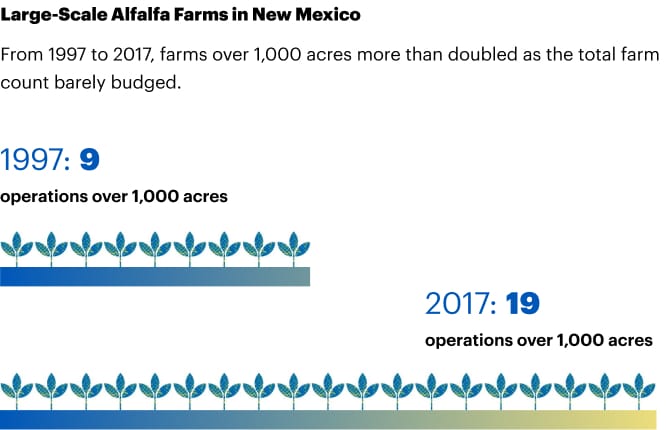
This dangerous feedback loop exacerbates New Mexico’s water woes. Production of cattle feed crops is the leading cause of river depletion in a third of all sub-watersheds in the American West, contributing to greater droughts that in turn reduce availability of water. All of this is only further exacerbated by climate change.71Richter et al. (2020) at 319 to 320.
In neighboring Arizona, research has found a correlation between increased alfalfa growth and declining water levels when groundwater is the crop’s main source of water.72Ford, Matthew T. “Trends in alfalfa growth and groundwater levels in Arizona.” Arizona Journal of Interdisciplinary Studies. Vol. 8, Spring 2022 at 2. Alfalfa is extremely dependent on groundwater in some of the top-producing areas in New Mexico. In Chaves County, one of two dominant alfalfa-growing counties in 2021, 97 percent of irrigation water was groundwater.73USDA and New Mexico Department of Agriculture (NMDA). “2021 New Mexico Hay County Estimates.” 2021; NM OSE. “Summary of Water Use in Acre-Feet in Chaves County, 2015.” Available at https://www.ose.state.nm.us/WUC/wucTechReports/2015/2015county.php. Accessed December 2022. If groundwater continues to be abused like this, nearby domestic wells will run dry.74Rawling, Geoffrey C. and Alex J. Rinehart. New Mexico Bureau of Geology and Mineral Resources. “Lifetime Projections for the High Plains Aquifer in East-Central New Mexico.” Open-File Report 591. July 2017 at 31.
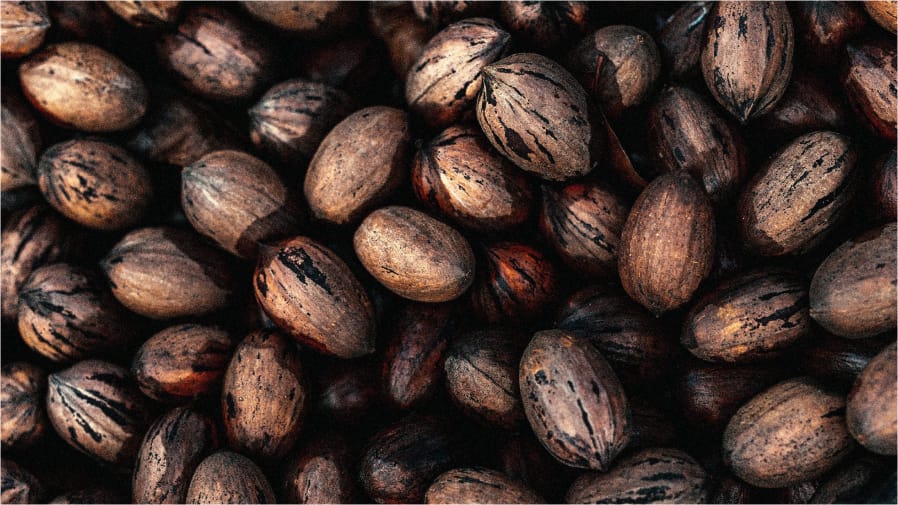
Pecans
New Mexico is the second largest pecan-producing state, producing a third of the nation’s pecans. The state produced over 78 million pounds in 2021, bringing in over $188 million.75USDA and NMDA. “2021 New Mexico Pecan County Estimates.” Available at https://www.nass.usda.gov/Statistics_by_State/New_Mexico/Publications/Special_Interest_Reports/NM-Pecan-CE-05122022.pdf. Accessed February 2023. But aside from being profitable, pecans are another extremely water-intensive crop. Food & Water Watch estimates that in 2021, pecans guzzled 93 billion gallons of water, enough to supply more than 3.2 million people — over 1 million more than live in New Mexico.76FWW analysis of USDA and NMDA. “2021 New Mexico Pecan County Estimates”; Griego, Tylee. University of New Mexico. “When high-water-use neighbors move in: Farming pecans in Valencia County, New Mexico.” May 2022 at 28 to 29; Magnuson et al. (2019); U.S. Census Bureau. “Quick Facts — New Mexico.”
Water is the single most important factor in pecan production, influencing every aspect of production. Water stress can lead to shedding leaves, dropped nuts, or unfilled pecans, wasting the crop.77Wells, Lenny. “Pecan water requirements and irrigation scheduling.” UGA Cooperative Extension Circular 1106. October 25, 2016 at 2. Pecans are not native to New Mexico, needing significant irrigation to supplement sparse rainfall.78Griego (2022) at 22. During peak water-use season, the required irrigation can be as much as 13,000 gallons per acre per day.79Ibid. at 29. Many pecan orchards are flood irrigated, like alfalfa, using as much water as possible. And when surface water reservoirs run low, farmers turn to groundwater for irrigation.80Hodnett, Dalene. New Mexico Farm & Livestock Bureau. “Assessing Western Drought Conditions — New Mexico Pecan Producers Beating the Odds With Irrigation Innovation.” Market Intel. October 7, 2021. In some years, groundwater can account for up to 90 percent of irrigated water in key pecan-growing regions.81Mokari, Esmaiil et al. “Evaluation of long-term climate change impact on the growing season and water use of mature pecan in Lower Rio Grande Valley.” Agricultural Water Management. Vol. 252. March 20, 2021 at 2.
Despite prolonged drought over the past 20 years, pecan production in New Mexico is on the rise. Since 2002, the acreage harvested for pecan production has increased by 11,000 acres — a 34 percent increase.82FWW analysis of USDA NASS. Quick Stats. This is partly sparked by greater pecan demand, which has increased due to export of pecans.83Griego (2022) at 22.
This growth means more stress on New Mexico’s water supplies to keep up with demand. Pecan production concentrates in similar patterns to other industries discussed — for instance, Doña Ana County, in addition to being on Dairy Row, is also the state’s largest pecan-producing county. In 2021, the county bore over 32,000 acres, while the next closest region bore a mere 2,400 acres.84USDA and NMDA. “2021 New Mexico Pecan County Estimates.” Concentrating so many water-intensive industries in one area rapidly depletes groundwater supplies, putting communities at risk.
Pecan production will become less viable as climate change intensifies. Snow is melting earlier than is needed for pecan growing, due to earlier warming and less snowfall, leading to depleted “banks” of surface water.85Griego (2022) at 20. From 1950 to 2019, the duration of the growing season has increased by 70 days, with similarly increasing temperatures. This lengthened season will negatively affect crop production, since water is a limited resource for irrigation.86Mokari et al. (2021) at 4. Adequate freezing time is also essential for productive pecan orchards. Despite the money and water being poured into the industry, climate change may simply make it too warm for continued pecan production in the state.87Griego (2022) at 25.
Problem #2: Lack of Data and Preparation
New Mexico has faced temporary drought and arid climates before, but climate change is an entirely different beast — for one, changes will be permanent. Status quo management is no longer an option.88Dunbar et al. (2022) at 81 to 82. Before policymakers can make targeted proposals and timelines, data are needed to predict where wells will go dry or simply how much water is left in the state — data that New Mexico does not have.89Fendt and Farmer (January 14, 2022). It is extremely difficult to prepare for a disaster if you have no idea when it is coming or how much time you have to prepare.
The state has no centralized agency tracking wells that are going dry or water use by sector,90Ibid. and New Mexico’s water management system does not go much beyond basics.91Grover, Hannah. “How much do we know about our watersheds? New study says gaps in knowledge exist because of ‘bias’ in stream gauge placement.” NM Political Report. May 10, 2022. This means that no one in the state knows how much time and water is left for New Mexico.92Fendt and Farmer (January 14, 2022). The New Mexico Bureau of Geology and Mineral Resources highlighted this issue in a recent report on aquifer lifetimes, writing that pumping quantities are not tracked and that groundwater use is estimated only every five years, through a variety of indirect estimates.93Rawling and Rinehart (2017) at 31.
Data that are collected favor high-population areas and larger rivers, leaving rural areas and small tributaries vulnerable, and the state is unable to tell if rivers are gaining or losing water.94Grover (2022). This inequity in water data is felt hardest in low-resource areas, where small towns are left to handwrite their water levels on well houses in attempts to track water status.95Fendt and Farmer (January 14, 2022).
When a crisis does hit rural areas, as it did in the village of Magdalena in 2014, it often comes without warning. Residents in Magdalena were left without running water when water levels dropped more than 15 feet within a year and the town’s sole functioning well ran dry. Solutions were found only after the fact, with the state government failing to collect the basic data needed to pre-empt such crises. When wells run dry, it fundamentally changes how residents think about water. Magdalena’s mayor says that he now thinks about water levels “every single day.” Even just pulling together data on a town’s history can be impossible — reports are misplaced or lost, and no state-wide database exists at present.96Ibid.

The Water Data Act
New Mexico has made halfhearted attempts to address these glaring holes, most notably by passing the Water Data Act in 2019, which directs agencies to collaborate on identifying and repairing gaps in water data. The act was heralded as a national leader in water data access legislation, one of the first of its kind to aggregate and standardize water data in a central and open database.97New Mexico Water Data. [Fact sheet]. “Water Data Act.” 2020; New Mexico Administrative Code (NMAC) § 72.4B.3; Grover (2022). This is managed by the New Mexico Bureau of Geology and Mineral Resources, but it is also a collaborative effort between other state agencies like the Office of the State Engineer and the New Mexico Environment Department.98New Mexico Bureau of Geology and Mineral Resources (BGMR) et al. “2022 Plan: New Mexico Water Data Initiative.” September 2022 at 1.
But despite its lofty goals, the Water Data Act was in trouble from the start. Providing open water data is expensive, with costs for data software, infrastructure, labor, and hiring arising quickly. This can be prohibitive, and a reluctance on the part of government to spend it prevents progress.99Sugg, Zachary. “Social barriers to open (water) data.” Wiley Interdisciplinary Reviews: Water. Vol. 9, Iss. 1. October 27, 2021 at 8. The Water Data Act is an unfortunate example of this latter problem: the bill’s initial appropriation was a measly $110,000. This increased to $400,000 in 2020, but only due to additional funding from external sources.100Fendt and Farmer (January 14, 2022); BGMR et al. (2022) at 7; New Mexico Water Data (2020). In 2023, implementation of the act will see its largest budget yet, at $1,400,000, although this is only allocated to three agencies.101BGMR et al. (2022) at 5.
Even this is nothing compared to what is needed. State agencies require a combined budget of $2.65 million annually to properly implement the Water Data Act, with an additional $6.5 million allocated for non-annual funds. Several key agencies have received no dedicated funding thus far and are struggling to hire people to implement the legislation.102Ibid. at ii and 6. In past examples, providing open data has fallen by the wayside for government officials, who choose not to prioritize the work as it does not fall under their regular work scope, making hiring dedicated employees even more important.103Sugg (2021) at 8.
This crisis will not wait for the government to catch up. Aquifers across New Mexico are increasingly threatened as climate change intensifies,104Rawling and Rinehart (2017) at 31; Dunbar et al. (2022) at 2. and without data to track where and by how much, the state will be unable to respond to acute water shortages. Governor Lujan Grisham has lamented the state of water data before and pledged to improve it,105Lujan Grisham, Michelle. [Press release]. “Managing and Conserving Our Water to Preserve Our Culture, Communities and Future Generations of New Mexicans.” October 29, 2018 at 4. yet she failed to include significant mention of the Water Data Act in her fiscal year 2023 budget recommendations. Many of the key agencies that require additional funding received no advocacy for dedicated funding.106BGMR et al. (2022) at ii and 6; Romero, Deborah K. et al. State Budget Division, Department of Finance and Administration. “State of New Mexico: Executive Budget Recommendations.” January 2022 at XIX to XX, 57 to 58. Failure to advocate for these programs is a failure to the state and its people, and New Mexico needs a leader that will treat this as the crisis that it is.
Problem #3: Poor Water Allocations
New Mexico water law is guided by the principles of prior appropriation and beneficial use, each of which threaten the state’s future water security.
Prior appropriation was officially codified in New Mexico’s 1912 state constitution,107Buynak, Brigette and Adrian Oglesby. “Basic Water Law Concepts.” (2008). Water Matters! at 3. dictating that, in times of shortage, the right to water is determined by the chronological order in which water was granted. This means that the earliest rights holders, including many agricultural water users, get the most water.108Ibid.; NM OSE ISC. “Legal Landmarks.” (2018) at 1; NM OSE. “Frequently Asked Questions.” Available at https://www.ose.state.nm.us/ProgramSupport/FAQ.php#8. Accessed January 2023. During shortages, junior rights holders — often municipalities and residential water users — may not receive any water at all, as shortages are not shared equally. No senior water user’s allocations are reduced (so long as there is enough water).109Buynak and Oglesby (2008) at 5; NM OSE “Frequently Asked Questions.”
Beneficial use means that water users retain their water rights only if they put the water to a beneficial purpose, although there are no preferences for one kind of beneficial use over another.110NM OSE ISC. “Legal Landmarks.” (2018) at 1. Nearly anything short of obvious waste can fit, ranging from domestic use to irrigation to agricultural and industrial applications to game fishing.111Buynak and Oglesby (2008) at 4; NMAC § 19.26.2.7(D) (2021). Criteria for groundwater allocations are effectively the same as surface water ones.112Buynak and Oglesby (2008) at 5.
In practice, these policies lead to extremely unjust water uses. Prior appropriation incentivizes senior water users to use their full allocation even when they do not need it. New Mexico’s water system is built on a doctrine of “use it or lose it,” meaning that if rights holders do not use their full allocation, their right to it in future years is lost.113Ibid. at 4; NMAC § 72.5.28 (2021). This drives senior agricultural rights holders to use all the water allocated to them rather than conserving, inevitably contributing to shortages throughout the state. Further, the state’s failure to prioritize essential uses — like domestic use — over the blatant water waste of these agricultural users, regardless of who holds “junior” or “senior” status, is a major shortcoming of New Mexico’s water policy, and it is beyond time for the state to address this.
There is also little consideration for how this antiquated priority system exacerbates water insecurity. According to New Mexico Water Code, the Office of the State Engineer, which administers all water rights in the state, must now consider public welfare and conservation of water when granting new permits.114New Mexico Statute Annotated (NMSA) § 72.5.6 and 72.5.7 (2021); NMSA § 72.12.3(D) (2021). However, these requirements were added by the legislature only in the 1980s, meaning that such considerations had no bearing or impact on any pre-existing water rights, including those of the most senior users.115NMSA § 72.5.6 and 72.5.7 (2021); NM OSE ISC. “Legal Landmarks.” (2018) at 3 and 15.
Moreover, the law excludes livestock well-watering rights from meeting these requirements, another capitulation to Big Ag.116NMSA § 72.12.1.2 (2021). Officials continue to proclaim their desire to use the limited remaining water for economic development, rather than “hoard it.”117Fendt, Lindsay and Annabella Farmer. “Troubled waters: It’s time to rethink water in New Mexico amid droughts.” Las Cruces Sun News. January 26, 2022. These policies were not built to withstand times of increasingly severe and sustained mega-droughts, and the blind refusal to acknowledge the severity of the current and approaching climatic changes will only lead to greater crises in the future.118Fendt and Farmer (January 26, 2022).
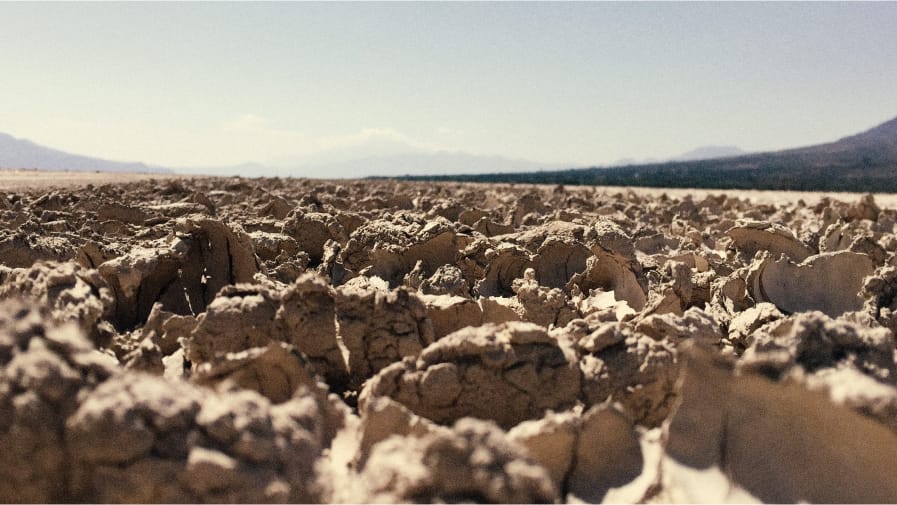
The state’s existing drought plans offer little help. While agency reports argue that status quo management is not an option,119Dunbar et al. (2022) at 89. the 2018 Drought Plan offers no suggestions for systemic water policy reforms. The primary focus of the plan centers on emergency response actions to deal with drought after it has already struck, and on problematic “mitigation measures” that do not offer real solutions.120NM OSE and Water Resources Research Institute. “New Mexico Drought Plan: 2018.” 2018 at 22.
Similarly, the 2018 Water Plan firmly aims to protect senior water users.121NM OSE ISC. “New Mexico State Water Plan Part I: Policies.” December 6, 2018 at 2, 13, and 32. Rather than scaling back the rights of senior users that overuse and pollute scarce water resources, the plan instead proposes industry scams like desalination and recycled water usage122Ibid. at 19, 32, 37, and 41. and even advocates for the creation of a water market system.123Ibid. at 32. Desalination and water recycling, although nice on paper, are both expensive and energy-intensive technologies that threaten the very communities they pose to protect.124Fountain, Henry. “The world can make water from the sea, but at what cost?” New York Times. Updated October 25, 2019; Jeffrey, P. et al. “The status of potable water reuse implementation.” Water Research. Vol. 214. February 2022 at 1; Keller, Arturo et al. “Direct potable reuse: Are we ready? A review of technical, economic and environmental considerations.” American Chemical Society ES&T Engineering. Vol. 2, Iss. 3. 2022 at B, C, H, and I. Meanwhile, water markets are simply another way for greedy speculators to profit off climate change and people’s suffering.125FWW. [Fact sheet]. “The Water Futures Market: Gambling With Our Water.” December 2021. The governor has also pushed these schemes in the past, advocating for water reuse and desalination during her campaign.126Lujan Grisham (2018) at 6.
No mention of scaling back agricultural and mega-dairy water abuses is an abject failure of leadership. Governor Lujan Grisham must address these core issues and advocate for a radical transformation in how New Mexico thinks about water. She must also resist giving in to the industry schemes. The state must de-prioritize water use for these water-sucking industries, as they consume disproportionate amounts of water relative to their value. Temporary solutions like fallowing land for a season are only stop-gap measures and are nowhere near the scale needed to address this crisis.
The Consequences
Inaction is costly. Aquifers across the state are draining rapidly, leaving wells dry and desperate families in their wake. Water levels in the High Plains Aquifer are declining at a rate of 1.5 feet per year — 90 times the recharge rate. Even if all groundwater pumping stopped today, water levels would not significantly increase across the aquifer in our lifetimes.127Rawling and Rinehart (2017) at 7. In the Clovis-Portales area, near the Texas border, aquifer levels have plummeted over 150 feet, imperiling drinking water.128Fendt and Farmer (January 14, 2022).
Families are suffering as a result. Domestic wells go dry disproportionately more than agricultural wells due to their shallow depths.129Perrone, Debra and Scott Jasechko. “Dry groundwater wells in the western United States.” Environmental Research Letters. Vol. 12. September 28, 2017 at 5. Since there are no measurements in New Mexico, no one knows exactly how many are dry, but across the American West overall, as many as 1 in 30 wells built since 1950 have run dry.130Ibid. at 9. New Mexico hydrologists have seen wells drop 30 feet in the span of a year.131Staten, Madison. “Measuring New Mexico’s groundwater remains challenging — here’s why getting it right matters.” KRWG. July 2, 2021.
Dry wells are concentrated in rural areas, where wells for domestic use are more common.132Perrone and Jasechko (2017) at 8. Small rural towns are facing unprecedented water shortages, leaving communities without water for a week or more. When their systems go dry, there is nothing to fall back on.133Land, Kyle. “Dry as a bone.” Albuquerque Journal. May 30, 2021. For instance, in the northern community of Buena Vista, following wildfires, residents had to walk down to irrigation ditches, fill up five-gallon buckets, and haul the water home just to flush their toilets. Much of the community is elderly, placing a nearly impossible burden on them. A new well costs around half a million dollars, and 600 mutual domestic water associations need similar replacements across the state.134Kraft, Ariana. “A northern New Mexico community’s well is running dry.” KRQE. Updated June 3, 2022. These barriers leave behind poor communities, and there is no guarantee that new well water will even last.135Perrone, Debra and Scott Jasechko. “Deeper well drilling an unsustainable stopgap to groundwater depletion.” Nature Sustainability. Vol. 2. August 2019 at 776; Land (2021). It also targets the Navajo Nation disproportionately — 30 percent of the tribe is not served by municipal water systems or reliable wells, making residents even more vulnerable to drought.136U.S. Environmental Protection Agency (EPA). [Fact sheet]. “What Climate Change Means for New Mexico.” EPA 430-F-16-033. August 2016.
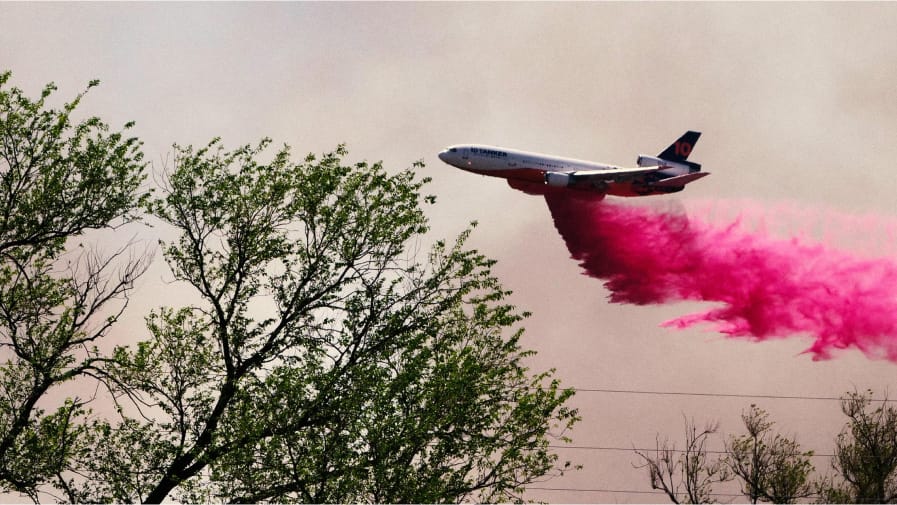
Small farms are also facing shortages. For instance, in 2021, the Middle Rio Grande Conservancy District banned surface-water irrigation. The district turned off the taps a month earlier than usual — the second time in two years. Farmers were forced to take on debt, switch crops, or dip into groundwater supplies, resulting in heavier burdens for small-scale farms.137Lohmann, Patrick. “‘It’s my livelihood’: Drought and restrictions could kill farms along Rio Grande, farmers say.” Source NM. October 11, 2021. The district is piloting programs to pay farmers to leave land empty, with over 2,500 acres left fallow in 2022. But 2022 saw massive rains come through, costing farmers far more than it helped. This is not a sustainable or long-term solution, and it costs the county money that could be used to build water resilience instead.138Gewin (2022).
Not only humans are affected — livestock and native ecosystems are equally threatened by New Mexico’s water woes. As droughts intensify, the availability of grassland grazing area for livestock declines.139Frankson et al. (2022). Hotter conditions will interfere directly with cattle welfare, resulting in lethargic cows that are unwilling to eat. They will grow slower and produce less milk.140EPA (2016). Increased heat will simultaneously increase the risk of mortality for livestock, partially through the expansion of new vector-borne and food-borne illnesses.141Rojas-Downing, M. Melissa et al. “Climate change and livestock: Impacts, adaptation, and mitigation.” Climate Risk Management. Vol. 16. February 10, 2017 at 148. Mega-dairies do not care for the welfare of their animals, and only when it begins to seriously cut into their profit margins will they start paying attention. Until then, they will milk the animals and land for as much money as possible, regardless of the social cost.
Increasing wildfires and dried-up waterways are also threatening New Mexico’s state fish, the Rio Grande cutthroat trout. Habitats are shrunken or dried up, leaving the trout unable to flee or cool off from growing wildfires. Too-large wildfires can incinerate so much of the banks that debris creates algal blooms in the remaining water, suffocating the fish. The cutthroat trout occupy a mere 12 percent of their historical range, and record wildfires in 2022 wiped them out from at least one stream.142Flesher, John and Brittany Peterson. “Climate-fueled wildfires worsen danger for struggling fish.” AP News. September 21, 2022.
When the Rio Grande went dry in 2022, much of the habitat of the endangered silvery minnow went with it. The minnow now swims in 7 percent of its historic range, despite being listed as endangered since 1994. Officials warn that current efforts for water usage are not enough to save the species and still provide water to human infrastructure.143Peterson, Brittany and Suman Naishadham. Associated Press. “The Rio Grande went dry in Albuquerque for first time in 40 years. A key fish habitat went with it.” USA Today. August 3, 2022. Relentless drought, water mismanagement, and corporate greed continue to threaten the minnow’s remaining habitat and population, and although efforts have been made to reintroduce the species, its survival simply comes down to needing more habitable water.144Ibid.
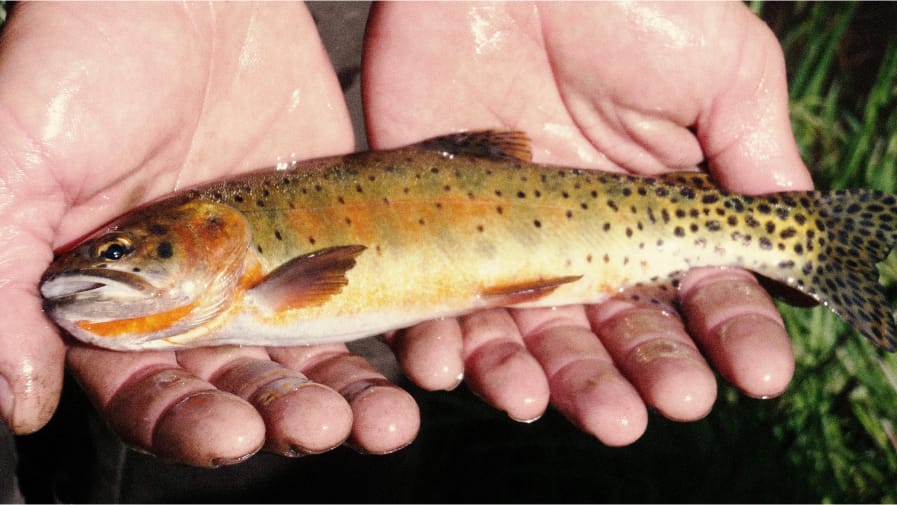
Conclusions and Recommendations
It is past time for New Mexico to address the corporate abuse of water. Water-intensive industries like mega-dairies, alfalfa, and pecans are using up vital water supplies needed by residents and communities across the state. Mega-dairies, in particular, also endanger community water quality, placing the health and safety of thousands at risk. Thus far, New Mexico has failed to step up and take the actions needed to address this as the crisis that it is.

Food & Water Watch recommends:
Stop egregious misuses of New Mexico Water
Governor Lujan Grisham and the Office of the State Engineer must:
- Deny all water permitting of new or expanding mega-dairies, alfalfa fields, and pecan acreage.
- De-prioritize industrial agricultural abuses and ensure that residential needs are prioritized above corporate greed.
- Advocate for scaling back these water-intensive industries.
Address industrial water abuse
- Stop issuing discharge permits to mega-dairies that continually contaminate groundwater sources.
- Create a State Drought Plan that clearly addresses the abuses of industrial agriculture’s water usage.
Protect human rights
- Respect the water rights of Indigenous communities and actively consult with Indigenous communities on water rights and best water management practices.
- Prioritize state support to rural and lower-income communities experiencing water and data shortages.
Provide strong oversight
- Reject industry schemes like desalination, recycled water usage, and water market systems.
- Appropriate sufficient funds to the Water Data Act and the respective state agencies to ensure that data are collected prior to crises. Governor Lujan Grisham must advocate for the inclusion of this funding in future budgets, and the Legislature must ensure its passage.
- Allocate more staffing and funding to the New Mexico Environmental Department to provide adequate resources to effectively inspect and punish mega-dairies contaminating groundwater.
- Track industry water usage consistently throughout the state and centralize the collection of dry wells data.
Tell Gov. Lujan-Grisham to protect New Mexico’s water!
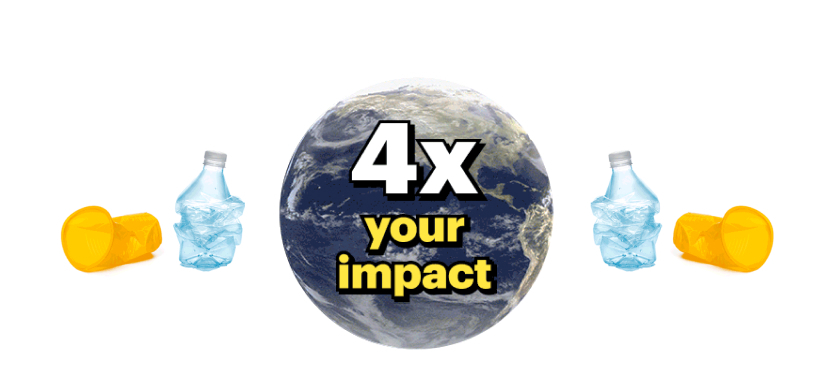
Time to face it —~it’s people or plastics.~We can’t have both.
Become a plastic pollution fighter this Earth~ Day and have your gift MATCHED $3-to-$1!
Endnotes



